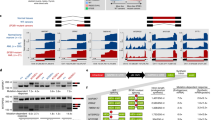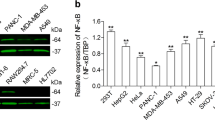Abstract
A trans-splicing ribozyme that can specifically reprogram human telomerase reverse transcriptase (hTERT) RNA was previously suggested as a useful tool for tumor-targeted gene therapy. In this study, we applied transcriptional targeting with the RNA replacement approach to target liver cancer cells by combining a liver-selective promoter with an hTERT-mediated cancer-specific ribozyme. To validate effects of this system in vivo, we constructed an adenovirus encoding for the hTERT-targeting trans-splicing ribozyme under the control of a liver-selective phosphoenolpyruvate carboxykinase promoter. We observed that intratumoral injection of this virus produced selective and efficient regression of tumors that had been subcutaneously inoculated with hTERT-positive liver cancer cells in mice. Importantly, the trans-splicing reaction worked equally well in a nude mouse model of hepatocarcinoma-derived peritoneal carcinomatosis, inducing the highly specific expression of a transgene, and moreover, the efficient regression of the hTERT-positive liver tumors with minimal liver toxicity when systemically delivered with the adenovirus. In addition to the observed hTERT-dependent therapeutic gene induction, significant reductions in the levels of hTERT RNA (∼75%) were also observed. In conclusion, this study demonstrates that a cancer-specific RNA replacement approach using trans-splicing ribozyme with a tissue-selective promoter represents a promising strategy for cancer treatment.
This is a preview of subscription content, access via your institution
Access options
Subscribe to this journal
Receive 12 print issues and online access
$259.00 per year
only $21.58 per issue
Buy this article
- Purchase on Springer Link
- Instant access to full article PDF
Prices may be subject to local taxes which are calculated during checkout





Similar content being viewed by others
References
Sullenger BA, Cech TR . Ribozyme-mediated repair of defective mRNA by targeted, trans-splicing. Nature 1994; 371: 619–622.
Jones JT, Lee SW, Sullenger BA . Tagging ribozyme reaction sites to follow trans-splicing in mammalian cells. Nat Med 1996; 2: 643–648.
Lewin AS, Hauswirth WW . Ribozyme gene therapy: applications for molecular medicine. Trends Mol Med 2001; 7: 221–228.
Long MB, Jones III JP, Sullenger BA, Byun J . Ribozyme-mediated revision of RNA and DNA. J Clin Invest 2003; 112: 312–318.
Fiammengo R, Jaschke A . Nucleic acid enzymes. Curr Opin Biotechnol 2005; 16: 614.
Lan N, Howrey RP, Lee SW, Smith CA, Sullenger BA . Ribozyme-mediated repair of sickle beta-globin mRNAs in erythrocyte precursors. Science 1998; 280: 1593–1596.
Phylactou LA, Darrah C, Wood MJ . Ribozyme-mediated trans-splicing of a trinucleotide repeat. Nat Genet 1998; 18: 378–381.
Rogers CS, Vanoye CG, Sullenger BA, George Jr AL . Functional repair of a mutant chloride channel using a trans-splicing ribozyme. J Clin Invest 2002; 110: 1783–1789.
Shin KS, Sullenger BA, Lee SW . Ribozyme-mediated induction of apoptosis in human cancer cells by targeted repair of mutant p53 RNA. Mol Ther 2004; 10: 365–372.
Kastanos E, Hjiantoniou E, Phylactou LA . Restoration of protein synthesis in pancreatic cancer cells by trans-splicing ribozymes. Biochem Biophys Res Commun 2004; 322: 930–934.
Kwon BS, Jung HS, Song MS, Cho KS, Kim SC, Kimm K et al. Specific regression of human cancer cells by ribozyme-mediated targeted replacement of tumor-specific transcript. Mol Ther 2005; 12: 824–834.
Hong SH, Jeong JS, Lee YJ, Jung HI, Cho KS, Kim CM et al. In vivo Reprogramming of hTERT by trans-splicing ribozyme to target tumor cells. Mol Ther 2008; 16: 74–80.
Jeong JS, Lee SW, Hong SH, Lee YJ, Jung HI, Cho KS et al. Antitumor effects of systemically delivered adenovirus harboring trans-splicing ribozyme in intrahepatic colon cancer mouse model. Clin Cancer Res 2008; 14: 281–290.
Thomson JA, Itskovitz-Eldor J, Shapiro SS, Waknitz MA, Swiergiel JJ, Marshall VS et al. Embryonic stem cell lines derived from human blastocysts. Science 1998; 282: 1145–1147.
Yui J, Chiu CP, Lansdorp PM . Telomerase activity in candidate stem cells from fetal liver and adult bone marrow. Blood 1998; 91: 3255–3262.
Forsyth NR, Wright WE, Shay JW . Telomerase and differentiation in multicellular organisms: turn it off, turn it on, and turn it off again. Differentiation 2002; 69: 188–197.
Kotoula V, Hytiroglou P, Pyrpasopoulou A, Saxena R, Thung SN, Papadimitriou CS . Expression of human telomerase reverse transcriptase in regenerative and precancerous lesions of cirrhotic livers. Liver 2002; 22: 57–69.
Fukazawa T, Maeda Y, Sladek FM, Owen-Schaub LB . Development of a cancer-targeted tissue-specific promoter system. Cancer Res 2004; 64: 363–369.
Song MS, Lee SW . Cancer-selective induction of cytotoxicity by tissue-specific expression of targeted trans-splicing ribozyme. FEBS Lett 2006; 580: 5033–5043.
Kim NW, Piatyszek MA, Prowse KR, Harley CB, West MD, Ho PL et al. Specific association of human telomerase activity with immortal cells and cancer. Science 1994; 266: 2011–2015.
Meyerson M, Counter CM, Eaton EN, Ellisen LW, Steiner P, Caddle SD et al. hEST2, the putative human telomerase catalytic subunit gene, is up-regulated in tumor cells and during immortalization. Cell 1997; 90: 785–795.
Smith LL, Coller HA, Roberts JM . Telomerase modulates expression of growth-controlling genes and enhances cell proliferation. Nat Cell Biol 2003; 5: 474–479.
Roesler WJ, McFie PJ, Dauvin C . The liver-enriched transcription factor D-site-binding protein activates the promoter of the phosphoenolpyruvate carboxykinase gene in hepatoma cells. J Biol Chem 1992; 267: 21235–21243.
Jaffe HA, Danel C, Longenecker G, Metzger M, Setoguchi Y, Rosenfeld MA et al. Adenovirus-mediated in vivo gene transfer and expression in normal rat liver. Nat Genet 1992; 1: 372–378.
Hendrie PC, Russell DW . Gene targeting with viral vectors. Mol Ther 2005; 12: 9–17.
Homma H, Doi T, Mezawa S, Takada K, Kukitsu T, Oku T et al. A novel arterial infusion chemotherapy for the treatment of patients with advanced pancreatic carcinoma after vascular supply distribution via superselective embolization. Cancer 2000; 89: 303–313.
Crettaz J, Berraondo P, Mauleon I, Ochoa L, Shankar V, Barajas M et al. Intrahepatic injection of adenovirus reduces inflammation and increases gene transfer and therapeutic effect in mice. Hepatology 2006; 44: 623–632.
Lee JS, Thorgeirsson SS . Genome-scale profiling of gene expression in hepatocellular carcinoma: classification, survival prediction, and identification of therapeutic targets. Gastroenterology 2004; 127: S51–S55.
Greenberg RA, Allsopp RC, Chi L, Morin GB, Dephino RA . Expression of mouse telomerase reverse transcriptase during development differentiation and proliferation. Oncogene 1998; 16: 1723–1730.
Horikawa I, Chiang YJ, Patterson T, Feigenbaum L, Leem SH, Michishita E et al. Differential cis-regulation of human versus mouse TERT gene expression in vivo: identification of a human-specific repressive element. Proc Natl Acad Sci USA 2005; 102: 18437–18442.
Sadeghi H, Hitt MM . Transcriptionally targeted adenovirus vectors. Curr Gene Ther 2005; 5: 411–427.
Wu L, Johnson M, Sato M . Transcriptionally targeted gene therapy to detect and treat cancer. Trends Mol Med 2003; 9: 421–429.
Folini M, Berg K, Millo E, Villa R, Prasmickaite L, Daidone MG et al. Photochemical internalization of a peptide nucleic acid targeting the catalytic subunit of human telomerase. Cancer Res 2003; 63: 3490–3494.
Li S, Rosenberg JE, Donjacour AA, Botchkina IL, Hom YK, Cunha GR et al. Rapid inhibition of cancer cell growth induced by lentiviral delivery and expression of mutant-template telomerase RNA and anti-telomerase short-interfering RNA. Cancer Res 2004; 64: 4833–4840.
Li S, Crothers J, Haqq CM, Blackburn EH . Cellular and gene expression responses involved in the rapid growth inhibition of human cancer cells by RNA interference-mediated depletion of telomerase RNA. J Biol Chem 2005; 280: 23709–23717.
White LK, Wright WE, Shay JW . Telomerase inhibitors. Trends Biotechnol 2001; 19: 114–120.
Jung HS, Lee SW . Ribozyme-mediated selective killing of cancer cells expressing carcinoembryonic antigen RNA by targeted trans-splicing. Biochem Biophys Res Commun 2006; 349: 556–563.
Won YS, Lee SW . Targeted retardation of hepatocarcinoma cells by specific replacement of alpha-fetoprotein RNA. J Biotechnol 2007; 129: 614–619.
Kim A, Bam G, Song MS, Bae CD, Park J, Lee SW . Selective regression of cells expressing mouse cytoskeleton-associated protein 2 transcript by trans-splicing ribozyme. Oligonucleotides 2007; 17: 95–103.
Acknowledgements
We thank Kazuhiro Oka (Baylor College of Medicine, Houston, TX, USA) for his kind donation of liver-specific promoter constructs. This work was supported by the Korea Science & Engineering Foundation grants (R01-2004-000-10436-0, M10534000004-06N3400-00410, and for the Medical Research Center for Cancer Molecular Therapy at Dong-A University), and grants from the Health 21 R&D Project (03-PJ1-PG3-21000-0008) and from the National R&D Program for Cancer Control by Korean Ministry of Health & Welfare. MS Song, G Ban, and YS Won are recipients of Brain Korea 21 fellowship.
Author information
Authors and Affiliations
Corresponding authors
Additional information
Supplementary Information accompanies the paper on Cancer Gene Therapy website (http://www.nature.com/cgt)
Rights and permissions
About this article
Cite this article
Song, MS., Jeong, JS., Ban, G. et al. Validation of tissue-specific promoter-driven tumor-targeting trans-splicing ribozyme system as a multifunctional cancer gene therapy device in vivo. Cancer Gene Ther 16, 113–125 (2009). https://doi.org/10.1038/cgt.2008.64
Received:
Revised:
Accepted:
Published:
Issue Date:
DOI: https://doi.org/10.1038/cgt.2008.64
Keywords
This article is cited by
-
Targeted Regression of Hepatocellular Carcinoma by Cancer-Specific RNA Replacement through MicroRNA Regulation
Scientific Reports (2015)
-
Adenoviral gene therapy in hepatocellular carcinoma: a review
Hepatology International (2013)



